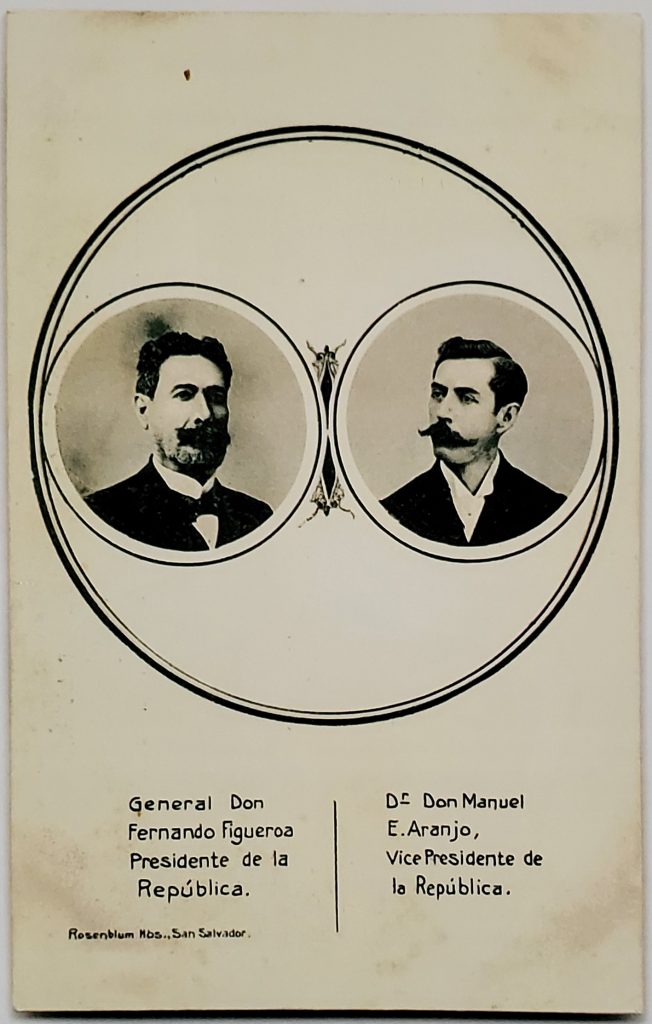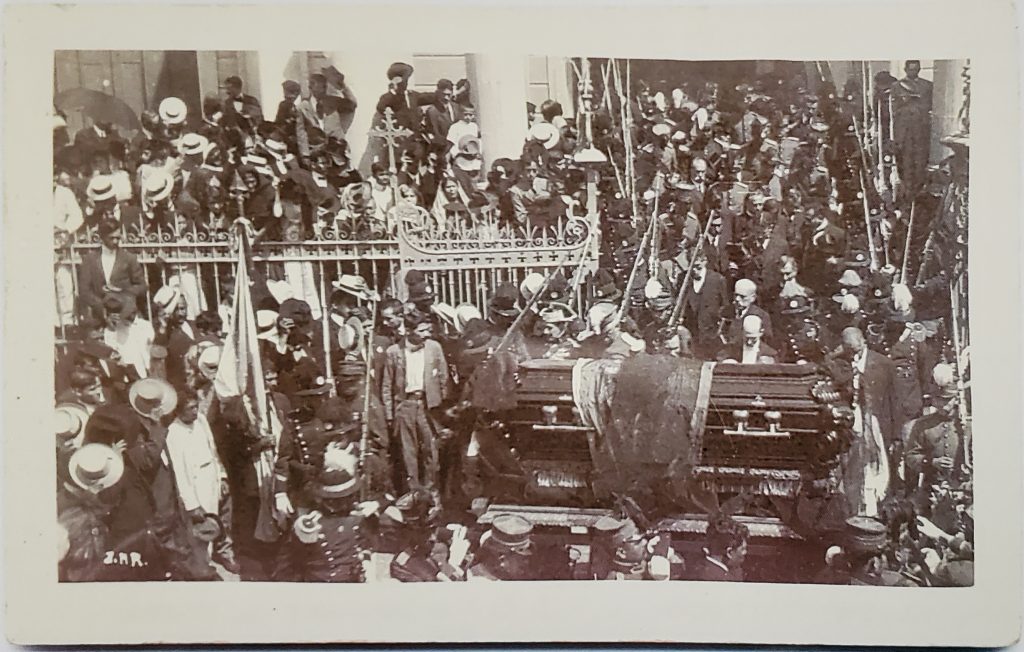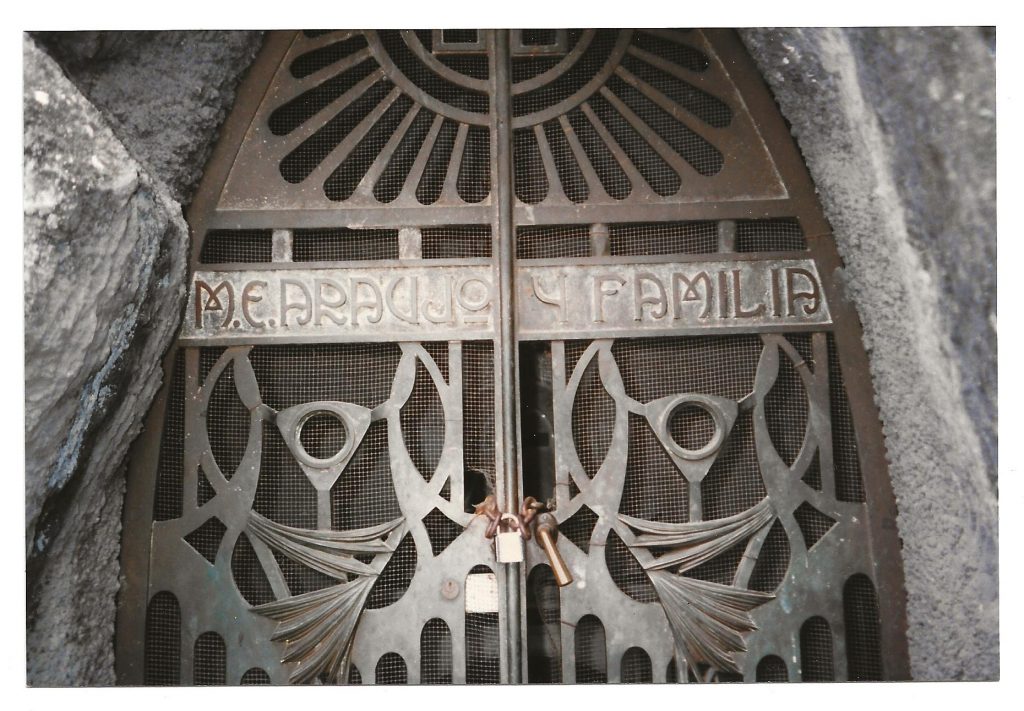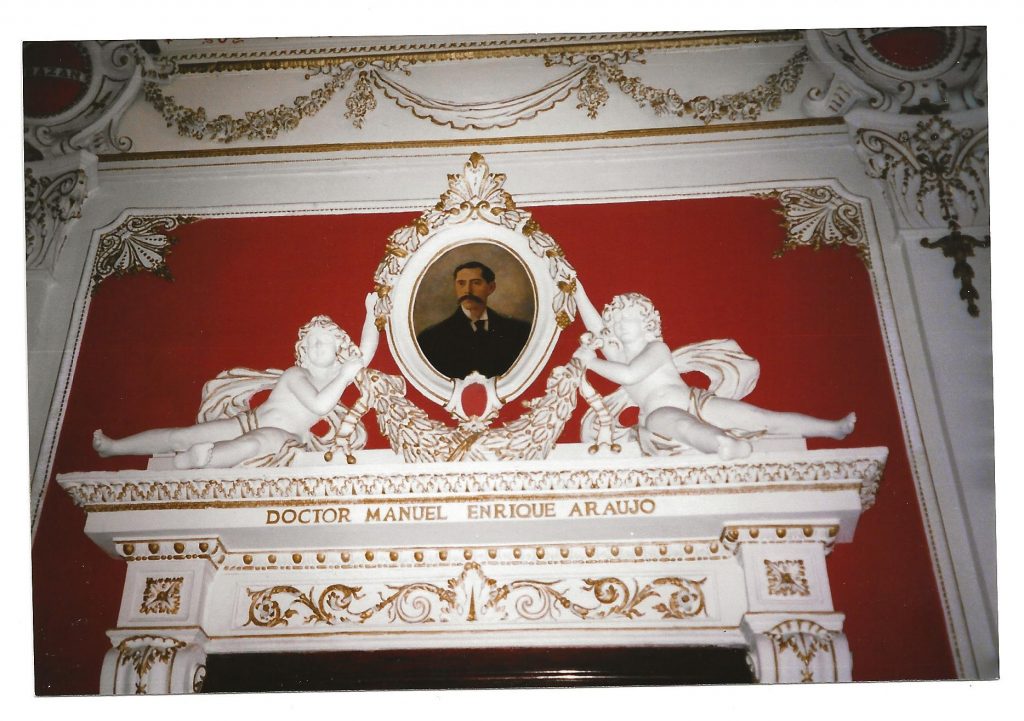
Fig. 1 Postcard of Salvadoran President Fernando Figueroa and
Vice-President Manuel E. Araujo
This is a rare (the only?) postcard depicting portraits of a Salvadoran President and Vice-President. The distributor of the card was Max Rosenblum, German merchant established in San Salvador and responsible for many of the first postcards circulated in the country.
Dr. Manuel Enrique Araujo (1865–1913) was Vice-President for the duration of the Presidency of Fernando Figueroa (1907–1911), and then was elected President. Several locations in the Department of Usulután claim his birthplace, among them the town of Jucuapa and his family’s hacienda in the Valley of Condadilla. Araujo’s father was Basque, his mother Portuguese.
Araujo studied medicine in El Salvador, specializing in surgery. His practicing medical career covered the decade of the 1890s, and into the first decade of the 20th century. He performed operations on prostate glands and eye tumors. He invented surgical instruments. As President, in 1911, he convoked and inaugurated in San Salvador, the first Central American Medical Congress. He was one of the first major coffee plantation owners, with estates in the Department of Usulután. Entering politics, he was elected deputy from Usulután, and subsequently Mayor of San Salvador.
Dr. Araujo served as Salvadoran President from March 1, 1911 until his assassination on February 4, 1913. He was accustomed to walking around downtown San Salvador very freely, with only one guard. The President especially fancied the parks, and had his favorite benches in each of them. In the evening he often went to the Bolívar Park (now Barrios Park), where he sat and listened to orchestral concerts. Sometimes he sat with friends and sometimes alone.
On the evening of February 4, 1913, he was sitting on a simple wooden bench with his brother-in-law, Tomás Vásquez Peralta and two old friends and colleagues: the Salvadoran Ambassador to the United States, Francisco Dueñas (1868–1945) and the former Mayor of San Salvador, Carlos Dueñas (1870–1917). The band, “Banda de los altos poderes,” under the direction of the Spaniard Pedro Ferrer y Rodrigo (1848–1933), had just played Franz Liszt’s Hungarian Rhapsody. At about 8:30 P.M. three assassins attacked the President, who received three machete wounds in the head and a revolver bullet in the shoulder. He died five days later on February 9.

Fig. 2 Postcard of Funeral Procession for of Salvadoran President Manuel E. Araujo
Arriving at National Cemetery in San Salvador
On February 10, the slain President’s embalmed body was exposed in the Blue Room of the National Palace in San Salvador. That day, and until the morning of February 12, the public filed by his casket. Then, the casket was taken between a double line of National Guardsmen to the Cathedral for a Requiem Mass. In this historic picture in front of the Cathedral on February 12, three men behind the President’s coffin can be identified: Dr. Ramón García Gonzáles, Dr. Gustavo S. Baron, and Dr. David Rosales.
At 11:00 A.M., the funeral procession with the bier drawn by six horses went from the Cathedral along 6e Calle to the corner of 8a Avenida Norte; then north to 7e Calle, and west to 13e Avenida Sur; and finally south to 4e Calle Poniente and the entrance to the Cementerio General de San Salvador. According to eye-witnesses, the procession was six blocks long. The iron fence one sees is that of the main entrance to the Cathedral. Also buried in this cemetery is the Italian aviator, Enrico Massi, the subject of a previous blog post, Enrico Massi, Italian aviator, dies giving a flying lesson in El Salvador, 1923

Fig. 3 Tomb of President Dr. Manuel E. Araujo and Family
Photo by Stephen Grant
Araujo’s mausoleum was designed by the artist, Carlos Alberto Imery (1979–1943). It is striking for its originality. Note the font of the capital letters: M. E. ARAUJO Y FAMILIA; they represent a combination of Art Nouveau and Art Deco styles, both of which inspired the artist. President Araujo encouraged Imery to open a School of Drawing and Painting in his home in 1912.
On the day of Araujo’s death, the National Assembly met, and decreed 30 days of mourning for the “fallen martyr.” Also on the day of the President’s death, his Vice-President, Carlos Meléndez (1861–1919), was sworn in as President. With President Meléndez’s support. Imery was named director of the newly created School of Graphic Arts in 1913. He later served as director of the National Museum from 1928 to 1930.
The simple wooden park bench where the attack on the President took place was displayed for many years in the David Guzman Museum. Currently [1997] it is being stored in an upstairs room of the National Palace. On the bench are written the names, “F. Dueñas,” “C. Dueñas,” and “Parque Bolívar.” One reminder of the President is the strip of the Pan-American Highway in San Salvador near the International Fairgrounds, entitled, “Alameda Dr. M.E. Araujo.” The Red Room of the National Palace in San Salvador contains painted portraits of both presidents.

Fig. 4 Painting of President Dr. Manuel E. Araujo in Presidential Portrait Gallery,
National Palace, San Salvador
Photo by Stephen Grant
Three farmers––Mulatio Virgilio, Firmin Perez, and Fabian Graciano––were arrested and executed after a military trial. Alfaro Menéndez was thought to have motivated the attack; he fled the country for two years.
Other Salvadoran Presidents assassinated were: Osmin Aguirre y Salinas, Enrique Álvarez Córdova, Ana María, Francisco Gómez, Maximiliano Hernández Martinez, and Manual Méndez.
(Text from Grant, Stephen, Postales Salvadoreñas del Ayer/Early Salvadoran Postcards. San Salvador, El Salvador: Fundación María Escalón de Núñez, 1999, 328 pp. Bilingual edition, pp 280–283.)
COMMENTS:
2 Comments
Submit a Comment
CONNECT

On your note of past El Salvador Presidents that were assassinated you mention Enrique Alvarez Cordoba…he was never President.
Also Fco. Gomez or Manuel Mendez were never President.
The other, Osmin Aguirre and Maximiliano Hernandez Martinez, they were Ex-Presidents, when assassinated.
I don’t know who you referred as Ana Maria (?).
Please correct. Thank you.
Thank you, Juan, for your helpful comment. When I wrote the text of Postales Salvadoreñas del Ayer almost 25 years ago in San Salvador, I wondered about other Salvadoran presidents who might have been assassinated, but never looked into the question. In 2022 from retirement in Virginia, I googled “Assassinated Salvadoran Presidents,” read through the list, and shared what I found. I am a believer in lifelong learning, and appreciate your observations.